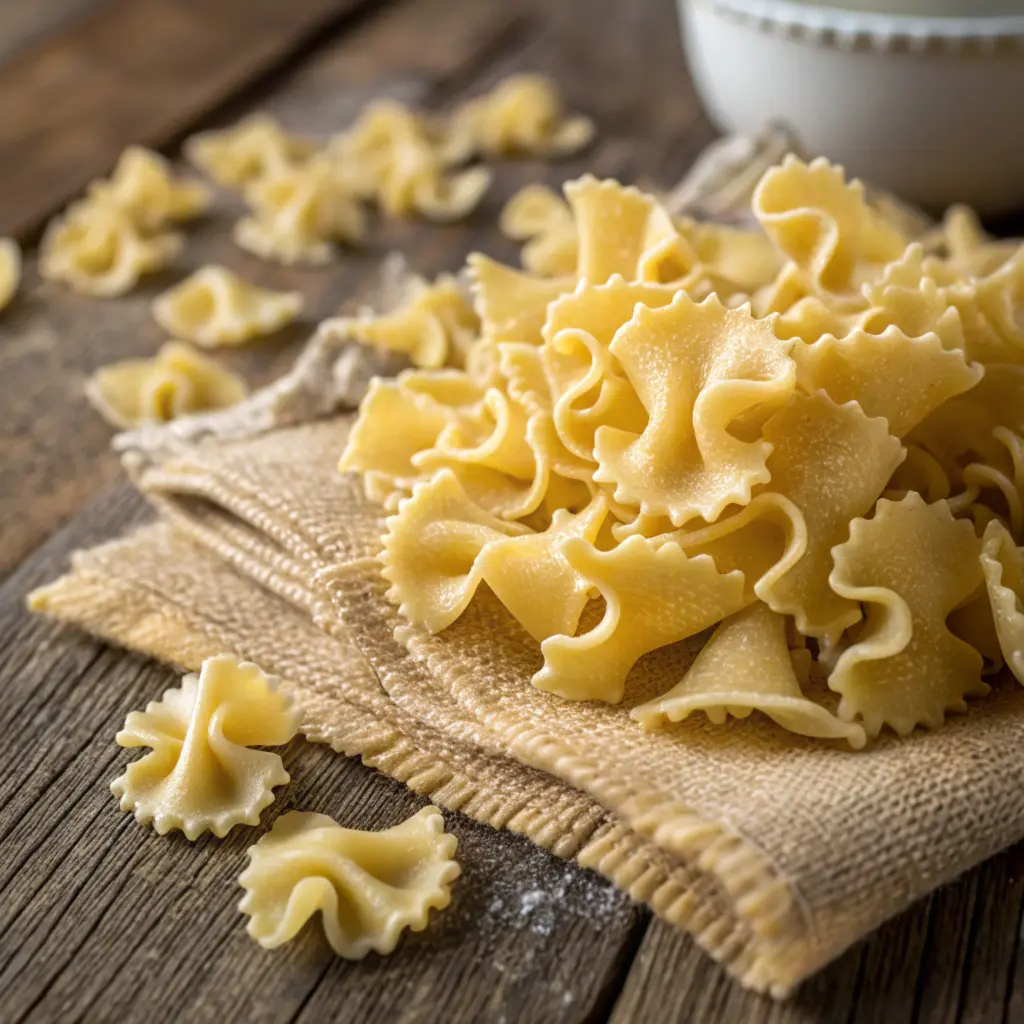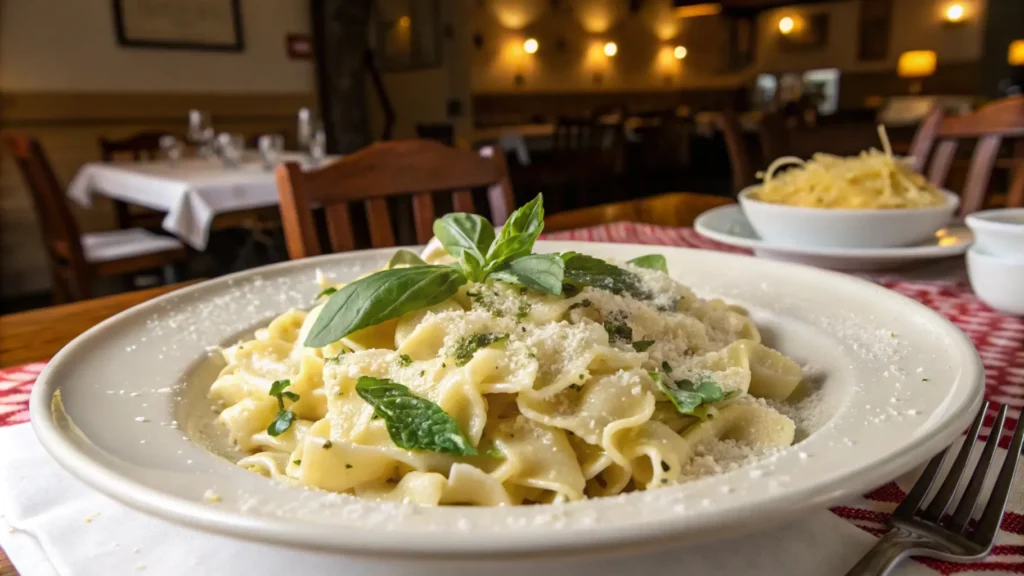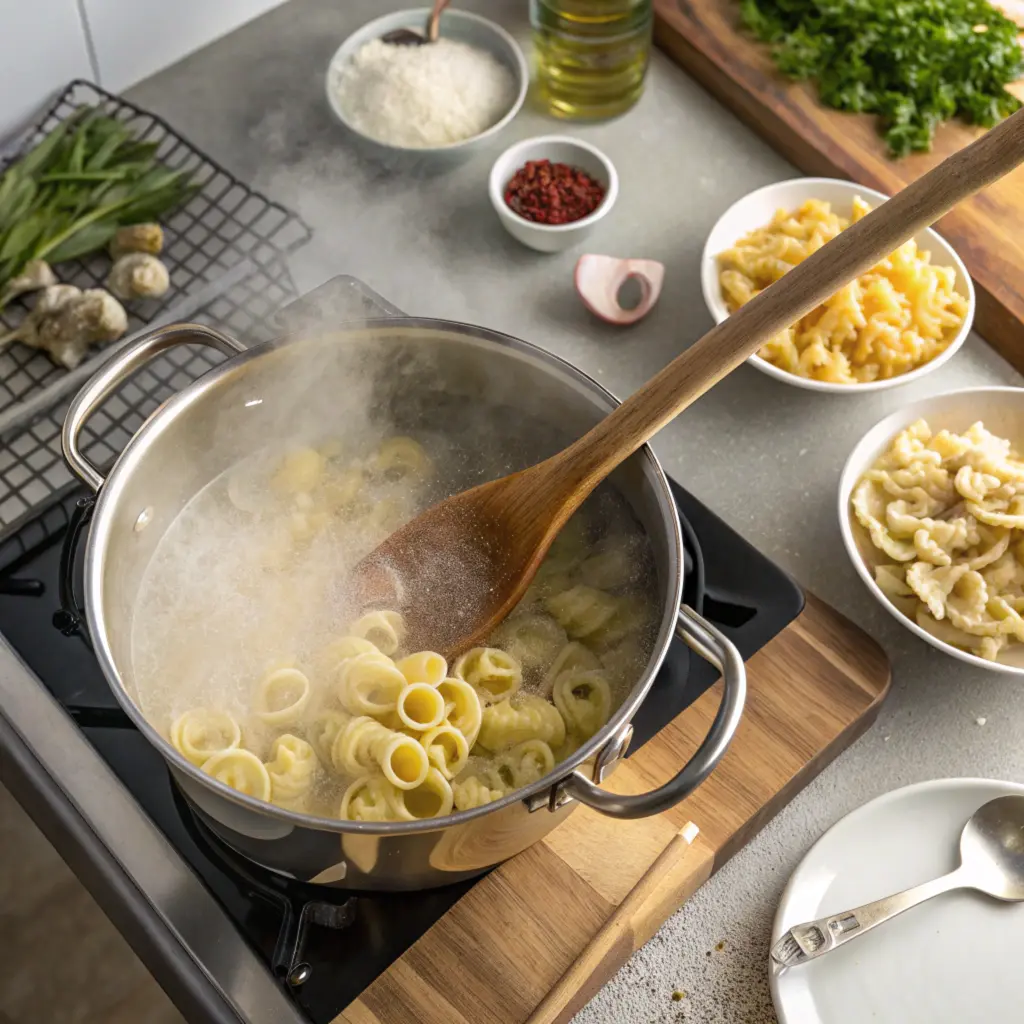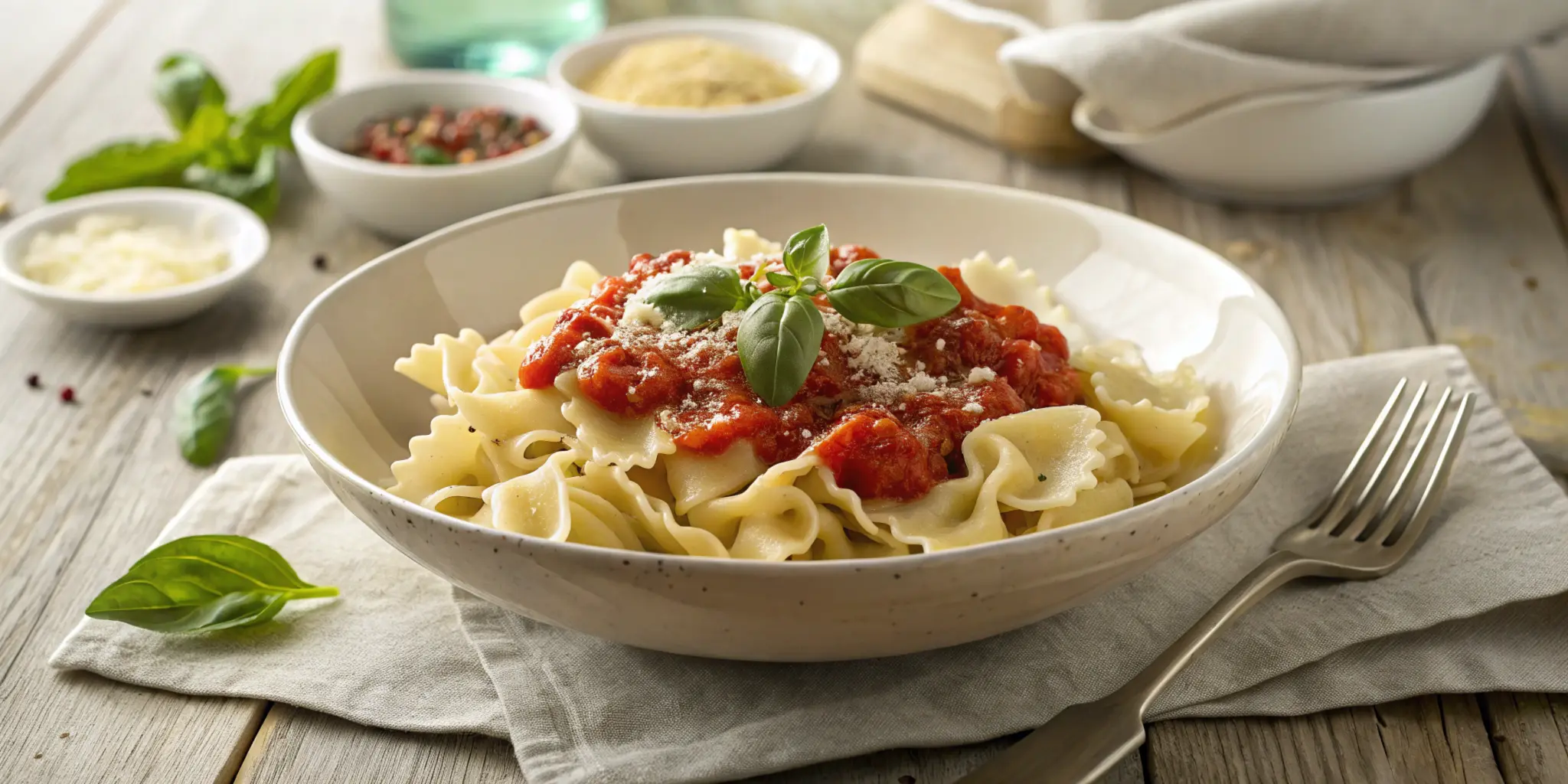Campanelle pasta, with its beautiful and unique bellflower shape, has captivated pasta lovers worldwide. But have you ever wondered what makes Campanelle so special? This article dives into its origins, uses, and why it stands out among other Italian pasta shapes. We’ll cover its history, characteristics, nutritional aspects, and culinary tips, offering a complete guide to mastering this delightful pasta. Ready to get started? Let’s break it down!
What Is Campanelle Pasta?
People often call Campanelle pasta bellflower pasta or gigli. This short pasta variety features ruffled edges and a tubular shape that mimics a cone or small flower. Its distinctive structure pleases the eye and serves a functional purpose by holding sauces, cheeses, and small toppings. Pasta makers craft Campanelle using semolina flour, which gives it a hearty texture and a mild, nutty flavor.
Etymology: The Origin of the Name ‘Campanelle’
The word “Campanelle” translates to “little bell” in Italian. This charming name perfectly describes its bell-like appearance. Historically, its shape symbolizes celebration and joy, often associated with traditional Italian festivities. Many regions in Italy have variations of pasta that echo this design, but Campanelle has become a favorite worldwide.
Historical Background and Regional Significance
Campanelle pasta originates from the heart of Italy, where pasta-making has been an art for centuries. While specific records of its creation are scarce, its resemblance to nature hints at its rural roots. Many believe that the shape of blooming flowers inspired artisans, who crafted pasta to reflect the beauty of their surroundings. Today, people around the world, not just in Italy, cherish it for its rustic charm in countless dishes.
For a full guide to campanelle pasta, including its history, popular recipes, and expert cooking tips, check out our complete guide here: Campanelle Pasta: A Complete Guide to History, Recipes, and Cooking Tips
Characteristics of Campanelle Pasta
Unique Shape and Structure
One glance at Campanelle pasta, and it’s easy to see why it’s so distinctive. Its name, meaning “little bell,” perfectly reflects its shape, which resembles a small, conical flower or a bell with delicately ruffled edges. This ingenious design isn’t just for aesthetics—it serves a practical purpose. The folds and curves of Campanelle create pockets that are perfect for trapping rich sauces, hearty ingredients like diced vegetables, and small chunks of protein.
Unlike flat or smooth pasta shapes, Campanelle has a dynamic structure that adapts to various recipes, making it versatile and fun to cook with. Whether you’re whipping up a creamy Alfredo or tossing it with a light pesto, the pasta holds flavor beautifully. Additionally, its compact size makes it easy to plate and serve. No wonder chefs love incorporating it into dishes that need both form and function.

Texture and Mouthfeel
One of the standout qualities of Campanelle is its texture. Made from high-quality semolina flour, it boasts a slightly rough surface that clings effortlessly to sauces. The ruffled edges add a bit of chewiness, providing a delightful contrast to smoother fillings or toppings.
When cooked al dente, Campanelle delivers a firm bite, ensuring that it doesn’t get lost among heavier ingredients. Its tubular shape adds to the satisfaction of each mouthful, giving a mix of tender and chewy textures that elevate any dish it’s part of. Whether in a robust meat sauce or a delicate cream-based recipe, its texture is simply unbeatable.
Common Ingredients Used in Production
Traditional Campanelle pasta is crafted using just a few simple ingredients: semolina flour and water. Semolina, derived from durum wheat, gives the pasta its characteristic yellow hue and hearty consistency. This flour is prized for its high protein content, which ensures the pasta holds its shape during cooking.
For fresh versions, eggs are sometimes added to enhance richness and give the pasta a silkier texture. However, dried Campanelle, widely available in stores, sticks to the classic flour-and-water combination. Some artisanal producers may experiment with alternative flours like whole wheat or gluten-free blends, but the essence of Campanelle remains the same—wholesome and minimally processed. Its simplicity is the secret to its universal appeal.
Culinary Uses of Campanelle Pasta
Ideal Sauce Pairings
Campanelle pasta is a sauce-lover’s dream! Its bellflower shape and ruffled edges are perfect for capturing every drop of sauce, ensuring a flavorful bite every time. The versatility of Campanelle makes it ideal for a wide range of sauces, from creamy to chunky.
Rich and creamy sauces like Alfredo or carbonara cling beautifully to the pasta’s folds, delivering a luxurious dining experience. For those who prefer a lighter touch, Campanelle pairs wonderfully with pesto, as the oil-based sauce coats each piece evenly. Tomato-based sauces like marinara or arrabbiata also shine with Campanelle, especially when complemented by fresh basil or grated Parmesan.
If you’re feeling adventurous, try it with hearty, chunky sauces like a Bolognese or a vegetable ragù. The pasta’s unique design holds onto bits of meat or vegetables, giving you a perfect balance of texture and taste. Campanelle is also a fantastic choice for cold pasta salads, where dressings and small toppings are evenly distributed.
Here is a table summarizing popular sauce pairings and suitable recipes for Campanelle pasta:
| Type of Sauce | Why It Works | Suggested Recipes |
|---|---|---|
| Creamy (e.g., Alfredo) | Coats the ruffled edges and tubular shape | Creamy Alfredo Campanelle, Cheese Pasta Bake |
| Tomato-Based (e.g., Marinara) | Fills the pockets and clings to the ridges | Marinara with Fresh Basil, Baked Campanelle with Marinara |
| Oil-Based (e.g., Pesto) | Lightly coats the pasta without overpowering | Basil Pesto Campanelle, Lemon-Garlic Pasta Salad |
| Chunky (e.g., Bolognese) | The structure traps meats and vegetables | Campanelle Bolognese, Vegetable Ragù Pasta |
| Brothy (e.g., Minestrone) | Holds its shape and texture in soups | Campanelle Minestrone Soup |
Popular Dishes Featuring Campanelle
From Italian classics to creative modern dishes, Campanelle pasta finds its way into countless recipes. A beloved choice in pasta bakes, Campanelle holds up well under heat, making it ideal for casseroles loaded with cheese and sauce. For example, a baked Campanelle with a three-cheese blend and béchamel sauce is a crowd-pleaser.
Another popular use is in hearty soups like minestrone. Its sturdy shape doesn’t disintegrate during cooking, making it perfect for brothy dishes with beans and vegetables. For lighter fare, toss Campanelle with sautéed garlic, olive oil, and roasted cherry tomatoes for a simple yet elegant meal.
Looking to add a protein boost? Pair Campanelle with grilled chicken, shrimp, or even tofu. This pasta also works well with seasonal vegetables like zucchini, mushrooms, or asparagus, creating dishes that celebrate fresh, vibrant flavors. With endless possibilities, Campanelle offers something for everyone.

Cooking Techniques and Tips
Cooking Campanelle pasta to perfection starts with a few key steps. Always use a large pot of salted boiling water, as Campanelle needs space to move around and cook evenly. The rule of thumb is about 4-6 quarts of water per pound of pasta, seasoned with a generous tablespoon of salt for flavor.
For al dente texture, cook Campanelle for 8-10 minutes, but check the package instructions for specific times. Stir occasionally to prevent sticking, especially during the first few minutes of cooking. Once done, drain the pasta, reserving a cup of the starchy cooking water. This water can be added to sauces for a silkier consistency.
If you’re preparing a baked dish, undercook the pasta slightly so it doesn’t become mushy in the oven. For salads, rinse the pasta briefly under cold water to stop the cooking process and remove excess starch. Always toss Campanelle with a bit of oil or sauce immediately after draining to prevent clumping.

Nutritional Information
Macronutrient Profile
Campanelle pasta is a solid source of energy, primarily due to its high carbohydrate content. For instance, one serving (approximately 2 ounces or 56 grams of dry pasta) contains about 200 calories, making it a staple for those who need a quick and satisfying meal. Moreover, it provides around 40 grams of carbohydrates, which are essential for fueling the body’s daily activities. As a result, it serves as an excellent option for individuals with active lifestyles or those in need of sustained energy.
Protein content ranges from 6 to 8 grams per serving, depending on the specific brand or whether eggs are used in its production. While not exceptionally high in protein, pairing Campanelle with legumes, meats, or dairy can easily boost its nutritional value. The fat content is typically minimal, making it suitable for low-fat diets. Its fiber content varies but is generally higher in whole wheat or enriched varieties, supporting better digestion and satiety.
Vitamins and Minerals
Traditional Campanelle pasta is not just about carbs; it also offers essential micronutrients. Durum wheat, the primary ingredient, contains B vitamins such as niacin, thiamin, and riboflavin, which play critical roles in energy metabolism and maintaining healthy skin, eyes, and nerves.
Iron is another key nutrient in Campanelle, providing about 10% of the daily recommended intake per serving. This makes it a good choice for those looking to maintain adequate iron levels. Enriched pasta varieties may also include folic acid, which is particularly beneficial for women of childbearing age. While it doesn’t pack a hefty mineral punch, the pasta acts as a versatile base for nutrient-dense additions like vegetables and lean proteins.
Health Considerations
When enjoyed in moderation, Campanelle pasta can fit well into a balanced diet. Its complex carbohydrates provide sustained energy, making it ideal for active individuals. However, portion control is key, as overeating pasta can contribute to excessive caloric intake, particularly if paired with high-fat or overly creamy sauces.
For those managing specific dietary concerns, such as blood sugar levels or gluten sensitivity, choosing whole wheat or gluten-free Campanelle may offer a better alternative. You can find more detailed advice on healthy eating and dietary adjustments at Healthline, a trusted resource for nutrition and wellness.
Purchasing and Storage
How to Select Quality Campanelle Pasta
Choosing high-quality Campanelle pasta ensures a better texture, flavor, and overall cooking experience. When shopping for dried Campanelle, look for brands that use 100% durum wheat semolina, as this guarantees the pasta’s firmness and golden color. The surface should appear slightly rough rather than shiny, as a rough texture helps sauces cling better.
If available, artisanal or bronze-cut varieties are excellent options. These are extruded through bronze dies, creating a porous surface that enhances sauce absorption. Check the packaging for an expiration date to ensure freshness, and avoid boxes or bags with broken pieces, as this can indicate poor handling.
For fresh Campanelle, examine its color and aroma. It should be a pale yellow and free of any sour or off-putting smell. Fresh pasta is often sold refrigerated, so make sure it’s stored properly at the retailer before purchasing.
Storage Guidelines for Fresh and Dried Varieties
Proper storage maintains the quality of Campanelle pasta. Store dried pasta in an airtight container or its original sealed packaging in a cool, dry place, away from sunlight and moisture. If you store it properly, dried Campanelle lasts up to two years.
Fresh Campanelle requires more careful handling since it is more perishable. Refrigerate it immediately and use it within 2-3 days of purchase. To extend its shelf life, freeze the pasta by laying it flat on a baking sheet until it solidifies, then transfer it to an airtight container. Frozen fresh pasta remains good for up to three months, and for the best texture, cook it directly from frozen.
Frequently Asked Questions
What is the best sauce for Campanelle pasta?
The best sauces for Campanelle pasta are those that cling to its ruffled edges and tubular structure. Creamy sauces like Alfredo or cheese-based varieties beautifully coat the pasta’s folds, while hearty tomato-based sauces, such as marinara or Bolognese, fill the pockets for a flavor-packed bite. Oil-based sauces like pesto or garlic-infused olive oil are also fantastic, especially when paired with fresh herbs and grated Parmesan. Chunky sauces with vegetables, beans, or diced meats are a perfect match too, as Campanelle traps the ingredients, creating a balanced texture and taste.
Can I use Campanelle pasta in baked dishes like lasagna or casseroles?
Absolutely! Campanelle pasta is an excellent choice for baked dishes like casseroles or layered pasta bakes. Its sturdy structure holds up well under heat, ensuring it doesn’t turn mushy in the oven. Use it in creamy baked recipes with béchamel sauce or cheesy casseroles where the pasta absorbs rich flavors. While it’s not traditionally used in lasagna, it can be a great alternative for creating layered dishes with vegetables, ricotta, or marinara sauce. The ruffled edges help trap the sauce, ensuring each bite is flavorful and satisfying.
What is a good substitute for Campanelle pasta?
If you can’t find Campanelle pasta, excellent substitutes include cavatappi, fusilli, or penne. These shapes share Campanelle’s ability to hold sauces and work well in a variety of dishes. Gigli, its close cousin, is also a great alternative.
If you’re out of campanelle pasta and need a quick alternative, discover the 10 best substitutes for campanelle pasta in our comprehensive guide: 10 Best Substitutes for Campanelle Pasta.
How to cook Campanelle pasta?
Cook Campanelle pasta in a large pot of boiling, salted water for 8-10 minutes until al dente. Stir occasionally to prevent sticking and follow package instructions for precise times.
How long to cook fresh Campanelle pasta?
Fresh Campanelle pasta cooks much faster than dried varieties, usually in 2-4 minutes. Boil it in salted water and check frequently to avoid overcooking.
For a detailed breakdown of how long to cook fresh campanelle pasta, including step-by-step instructions and helpful tips, check out our complete guide here: How Long to Cook Fresh Campanelle Pasta.
What is the difference between gigli and Campanelle?
Gigli and Campanelle are often used interchangeably, but there’s a slight difference in shape. Gigli typically has a more pronounced cone-like structure, while Campanelle features wider, more open ruffles resembling a bellflower. Both are excellent for holding sauces and are close substitutes for one another.
If you’re curious about the differences between gigli and campanelle pasta, including their unique uses and best cooking tips, explore our in-depth comparison here: Gigli vs. Campanelle: Key Differences, Uses, and Tips.
Conclusion
Campanelle pasta, with its unique bellflower shape and versatility, is truly a gem in the world of pasta. Whether you’re crafting a creamy Alfredo dish, a hearty Bolognese, or a vibrant pesto salad, this pasta adapts beautifully to a variety of recipes. Its ability to hold sauces and toppings makes every bite satisfying and full of flavor.
Rooted in Italian tradition, Campanelle brings history and charm to the table, offering a taste of authenticity with every dish. Its simple ingredient list, combined with thoughtful preparation, ensures a delightful culinary experience that’s as enjoyable to cook as it is to eat.
As we’ve explored, understanding the nutritional value, selecting high-quality products, and learning proper storage and cooking techniques can elevate your meals to the next level. Don’t hesitate to experiment with different sauces, proteins, and vegetables to make this versatile pasta your own. Whether you’re a seasoned chef or a home cook, Campanelle is a delicious choice that never disappoints.
So, the next time you’re looking to add a touch of elegance and functionality to your meal, reach for Campanelle pasta—your kitchen and taste buds will thank you!

